When diagnosing gout, doctors recommend that patients first change their diet along with medication. Diet for gout is an important component of a comprehensive treatment of the disease. Its use accelerates recovery as much as possible, quickly relieves symptoms, reduces the severity of attacks and prolongs remission.
Principles and benefits of diet
The main goal of diet therapy is to organize a diet that helps fight pathology and prevent relapses. The diet for gout is aimed at:
- regulation of purine metabolism;
- reduction of urate;
- Excess uric acid to remove the normalization process;
- regulation of metabolic processes;
- increase urinary alkalinity;
- lose weight;
- the general health of the patient.
The hypopurine diet is based on the principles of therapy and dietary regimens, including the prohibition of foods high in purine compounds, salts and oxalic acids. It is also necessary to reduce the amount of fat, carbohydrates and protein compounds consumed.
Therapeutic nutrition and diet for gout involves increasing the proportion of vegetables, fruits, natural drinks, kefir and cheese in the diet. The most effective is a 4-5 one-time proper diet with an average calorie in the range of 2500-2800 units.

An important!
Drinking regimen should ensure the flow of fluid to the body in the amount of 2. 5 liters or more.
How to organize a meal
To increase the effectiveness of your diet for gout, you need to follow a few tips:
- the main way of cooking - boiling, baking, steaming;
- After 10 minutes of boiling, drain the meat broth;
- alternative meat, fish and vegetarian dishes;
- use only natural liquids;
- holding fasting days;
- Avoid fasting.
An important!
In the presence of chronic diseases, it is necessary to consult a specialist to develop an individual nutrition system.
The main types of diets
Proper therapeutic nutrition does not completely eliminate gout, but it significantly alleviates the appearance of the pathology and prevents its recurrence. The type of diet prescribed often depends on the general condition of the patient, his weight, the presence of additional diseases, and even sex.
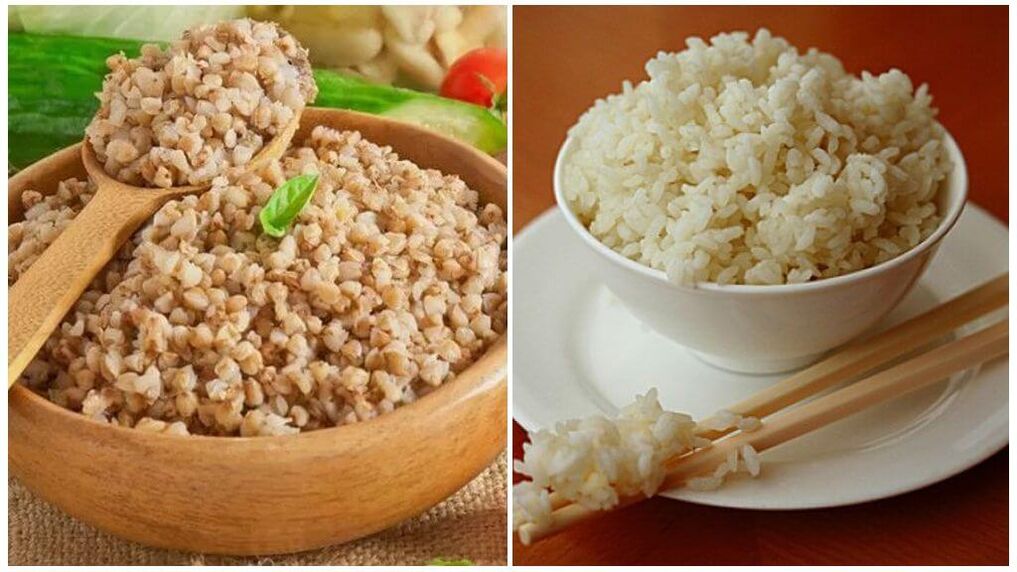
The main type of medical nutrition for gout is diet - table № 6. In addition, patients with gout, especially those suffering from respiratory and overweight, often use a diet №8 table, alkaline, rice and buckwheat diet. Kefir, cottage cheese, fruit or vegetable diet is best for fasting days.
Diet Table №6
It is prescribed primarily for patients with gout. This allows you to normalize the metabolism of purine compounds in the short term and eliminate the causes of crystallization and accumulation of uric acid salts.
Adherence to dietary requirements reduces the activity of uric acid reactions in the body. As a result, the patient's well-being improves rapidly, the inflammatory process stops, the swelling decreases, joint pain and loss of sensation disappear.
Diet for high uric acid
It is based on high-index purines, refractory oils, and salts with menu products to reject or reduce.
It is recommended to replace them with foods that have an alkaline effect: milk, sour milk, cottage cheese, fruits and vegetables. The diet is fasting one day a week.
Diet against gout exacerbation
First, increase the amount of fluid you drink to 3 liters. Then completely remove the meat and fish dishes. Animal protein deficiency can be compensated by increasing the proportion of milk and fermented milk products in the diet.
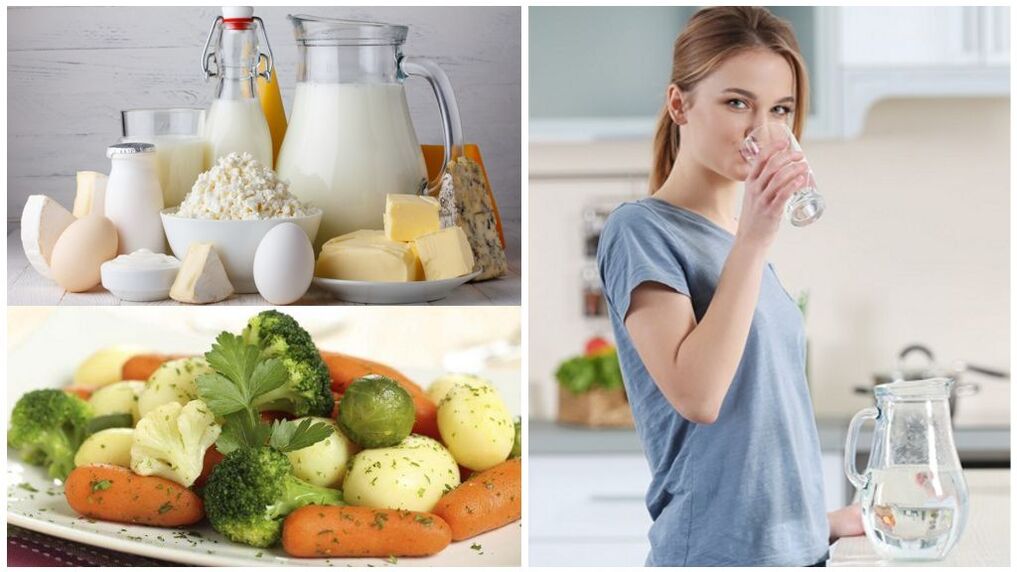
Until the end of the acute phase of the disease, fasting days should be organized every day and eat one type of food (cottage cheese, kefir, boiled vegetables, fruits).
An important!
Fasting causes a sharp release of uric acid and is strictly prohibited in gout.
Diet table №8
Table №8 regulates nutrition for severely overweight patients with gouty legs. This diet is aimed at increasing metabolism and getting rid of excess fat in the body.
The main difference between the general requirements for the treatment of gout in this case is the average reduction in caloric intake and fluid intake, on average up to 1. 5 liters per day.
As a warning!
Diet for men with gout ensures that the caloric content of food is not less than 2100-2500 units. The number of diets for women with gout is limited to 8 in the menu range from 1400 to 1700 kcal.
Buckwheat diet
The low calorie content of buckwheat allows it to be used for therapeutic dietary nutrition. Consumption restores disturbed metabolic processes, gives a feeling of fullness and allows you to forget about hunger for a long time. Buckwheat is a leader in all types of vitamins and trace elements.
Plant grain protein is well absorbed and is able to completely replace the animal. The product promotes the process of regeneration in the stage of recovery of bone and muscle tissue. Buckwheat porridge in combination with kefir is ideal for fasting days for gout.
As a warning!
Buckwheat is often prepared without salt in the diet. The buckwheat diet allows for rapid weight loss, which has a positive effect on the joints, which are prone to the devastating effects of gout.
rice diet
A rice-based diet is often used to cleanse and lose weight. Rice with gout speeds up metabolism, removes excess water and salt, and suppresses tumors. The manganese, selenium, phosphorus, iron and zinc contained in rice have a beneficial effect on all vital systems of the body.
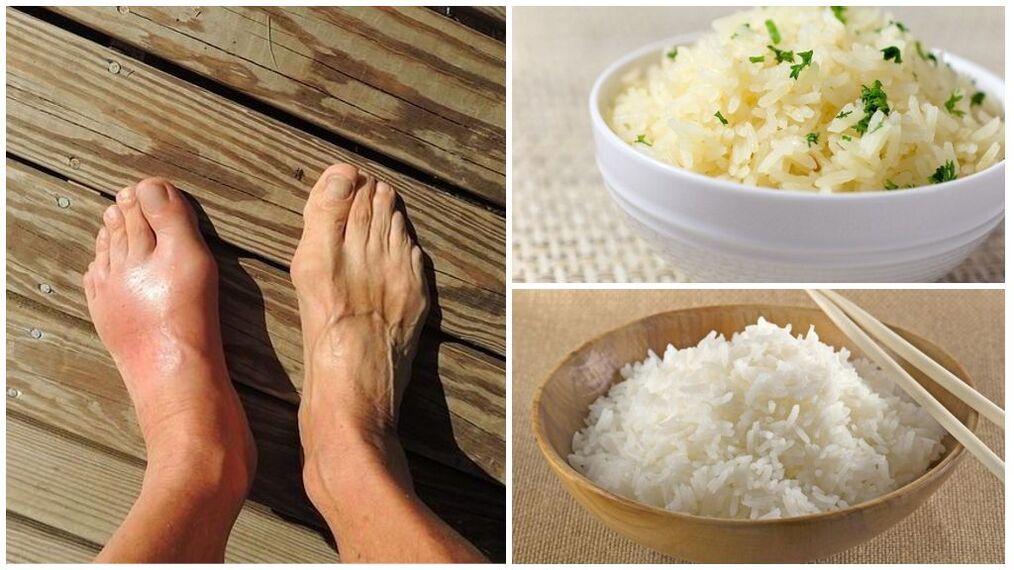
The porous structure of cereals releases harmful toxins, salts and slag accumulated from diseased joints. The rice diet can also be used for fasting days, especially when gout is severe.
An important!
Only brown or white long grain steamed rice is used for the diet. These cereals can be used daily in the treatment of gout with food.
alkaline diet
Increased acidity in the body has a negative effect on metabolic processes. This is accompanied by a lack of calcium and damage to bone tissue. The use of an alkaline diet can help prevent health-threatening processes. The diet is based on fruits, sour milk and dairy products. This diet can be used both in the period of exacerbation of gout and in remission.
Prohibited and permitted products
In order to properly restore the nutritional system, it is necessary to know which foods are useful and helpful in the fight against gout, and which are harmful and aggravate the disease.

All foods can be listed in the table of the main products of the diet for gout, depending on the quantitative content of purines, salt, fat and other harmful substances. The main feature of the distribution of the list of products for gout is the content of purine compounds.
| High in purines | Low purine |
|---|---|
|
|
An important!
It is strictly forbidden to drink any amount of alcoholic beverages for gout.
What products are useful
By determining the levels of purines and harmful fats in foods, you can know exactly which foods to eat and which to limit without compromising gout and health.
As a warning!
Pears, bananas and apples are among the foods that are especially good for gout. Malic acid, which is part of fruits, is able to neutralize the action of uric acid.
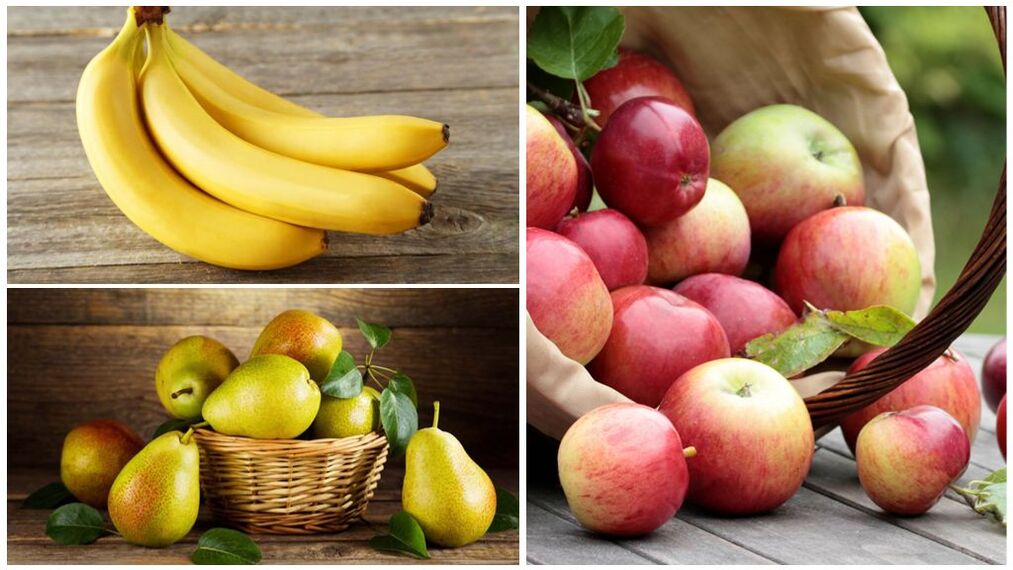
Potassium destroys uric acid crystals, which promotes its rapid elimination from the body. Ascorbic acid heals, repairs and strengthens connective tissue. Nutrition of fruits, which are especially useful in fermented dairy products.
Regular use of fresh cherries and cherry compote will bring great benefits for gout. Fruits contain antioxidants that fight free radicals. Bioflavonoids and anthocyanins prevent the inflammatory process in gout.
The nutrients in strawberries and strawberries neutralize uric acid and prevent the formation of its crystals in the joints.
As a warning!
You can include an unlimited number of these fruits in your diet for gout.
What foods should not be eaten
In addition to the foods listed in the final table, strong meat, fish and mushroom broth should be excluded from the diet. They are contraindicated due to the high content of purines, which can lead to acute exacerbation of gout. Unnecessary and canned meat containing fish and high percentage of salt. Their use disrupts the water-salt balance with the purine diet and promotes the additional deposition of salts in the tissues of the joints.
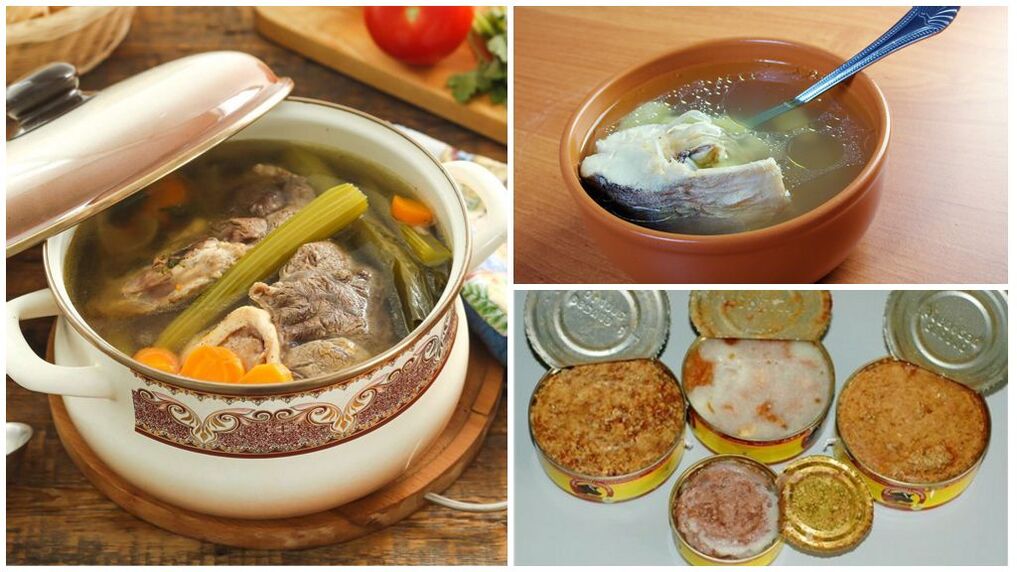
Prohibited foods for gout include tea, coffee and cocoa. These drinks should not be consumed with gout, because they trap uric acid in the body and disrupt its excretion. This leads to a recurrence of the disease.
Daily menu for the week
An extensive list of products that can be used allows each patient with gout to individually choose the dishes and eat properly. The diet recommended for the week is balanced, complete and consists of foods that are good for gout.
| Breakfast 1 | Omelet with herbs, rose hips, carrot salad |
| Breakfast 2 | Banana, kefir |
| The dinner | Vegetable soup with vermicelli, boiled potatoes, rabbit in onion sauce, apple juice |
| afternoon tea | Apple, cheesecake, lemon tea |
| The dinner | Zucchini caviar, kissel |
| Breakfast 1 | Rice porridge, pear soup, tomato salad |
| Breakfast 2 | Fruit salad, jelly |
| The dinner | Onion soup, barley porridge with forest mushrooms, dried fruit compote |
| afternoon tea | Pears and pumpkin ripening |
| The dinner | Cheese souffle, linden tea |
| Breakfast 1 | Wheat porridge, apricot juice |
| Breakfast 2 | Yogurt with cherries, rose hip broth |
| The dinner | Fish roast, vegetable roast, apple jelly soup |
| afternoon tea | Cheese pies with sour cream, compote |
| The dinner | pilaf with prunes, kefir |
| Breakfast 1 | Put in a bowl of rice, milkshake and apples |
| Breakfast 2 | Strawberries with sour cream, green tea |
| The dinner | Beetroot with sour cream, buckwheat, prunes and turkey breast, mint tea |
| afternoon tea | Pancakes with strawberries, carrot juice |
| The dinner | Cheese casserole with herbs, pear compote |
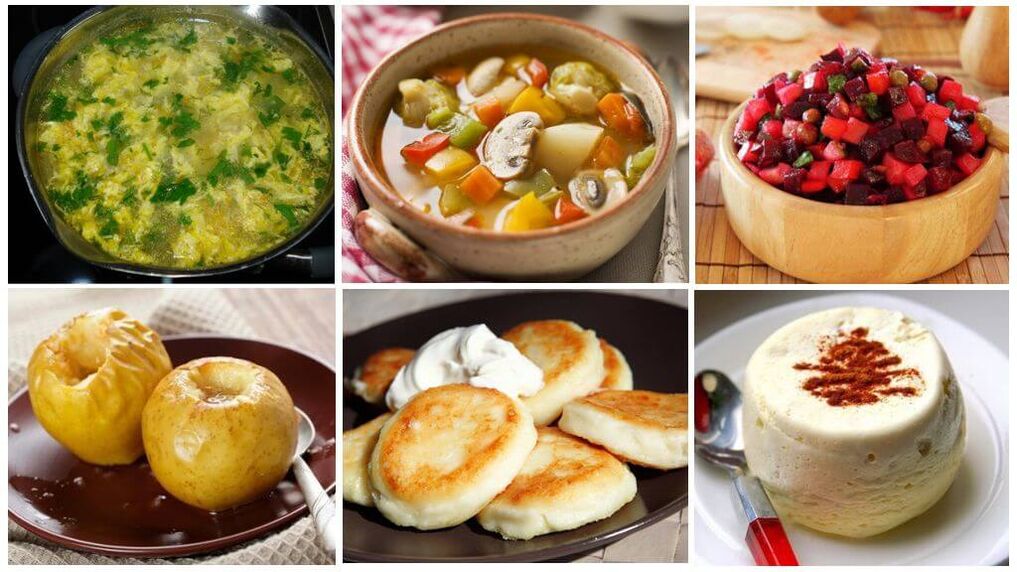
| Breakfast 1 | Oatmeal with raisins, tomato juice, fruit salad |
| Breakfast 2 | Cucumber salad with olive oil and orange juice |
| The dinner | Buckwheat soup, cooked zucchini with rice, orange juice |
| afternoon tea | Bananas, oatmeal |
| The dinner | Fish cooked with vegetables, kefir |
| Breakfast 1 | Millet porridge, plum juice |
| Breakfast 2 | Salad with young carrots and garlic, plus apples |
| The dinner | Egg soup, cabbage rolls with vegetables and turkey, apple juice |
| afternoon tea | Cheese with banana, strawberry tea |
| The dinner | Rice pudding, tomato juice |
| 1st breakfast | Boiled eggs, green tea |
| 2 breakfasts | Green tea with pears, marshmallows |
| The dinner | Meatless borsch, pasta and cheese, fruit compote |
| afternoon tea | Baked apples with cheese, lemonade |
| The dinner | Vinaigrette, boiled linden |
Permitted vegetables and fruits can be used in unlimited quantities in addition to the main menu. Wheat bread is better not to use for people with gout, including the big toe.
An important!
Foods with natural honey for gout can cause an allergic reaction.
Diet recipes
The recommended sample menu includes many diet foods tailored to what you need to eat per week. If you wish, you can replace them with a list of foods that are allowed for gout and suggestions on what to eat and what not to eat with gout.
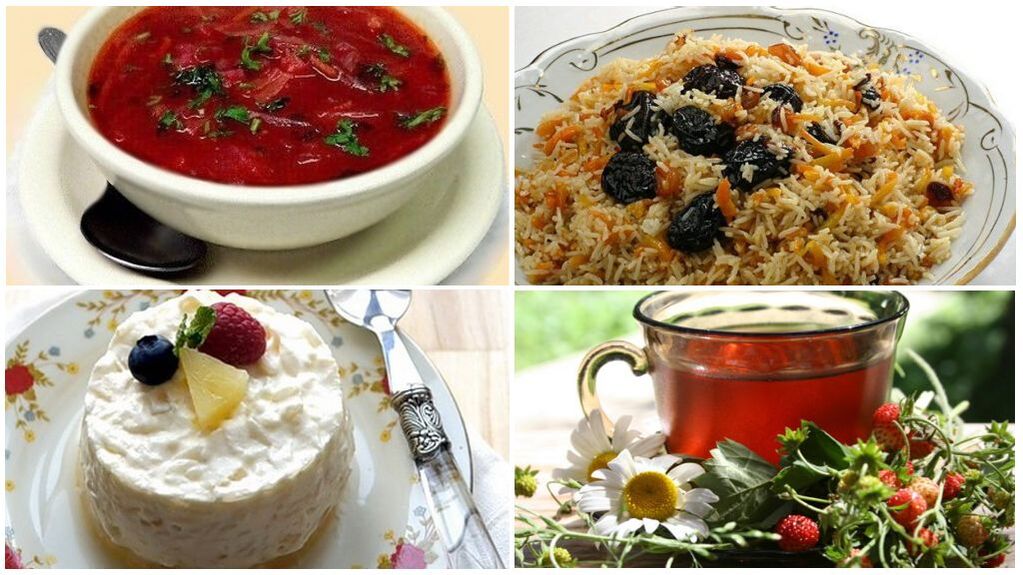
Debt without meat
1 Peel the beets, carrots and onions. Boil finely chopped onions and chopped root vegetables in olive oil with tomatoes or 1 tbsp. l. a tomato. Cut 4 potatoes into cubes and boil in 1, 5 liters of water. 10 min. Before cooking, add the chopped fresh cabbage to the strips. 5 min. - Vegetable soup. Season with salt to taste. When serving, add parsley, dill and a tablespoon of sour cream.
pilaf with prunes
Shake a glass of rice. In a saucepan with vegetable oil, put 2 onions cut into strips and 2 carrots into cubes. Boil everything a little. Add 10 washed and sliced prunes. We spend everything until the vegetables are soft. Pour in the rice, mix thoroughly with the oil and pour 2 cups of boiling water. Add spices and salt to a minimum. After boiling, reduce the heat and cook for 20 minutes under a tight lid.
rice pudding
Boil half a cup of rice in 1 liter. water 10 minutes. Drain the water and shake the rice. Pour a glass of milk and cook for another 25 minutes. until you get a soft porridge. Beat 2 eggs and cook 50 g of raisins. Mix everything with the chilled porridge, add salt to the tip of a knife and cook for 1 h. k. Sahara. Bake in the oven over medium heat until golden brown. Serve with cherry syrup.
strawberry tea
Pour a glass of boiling water over a pinch of dried leaves with strawberries and soak for 3 minutes. Drink without sugar.
With these recipes for every day, you can improve your well-being and reduce the appearance of pathology.
Conclusion
Proper nutrition for gout should become a daily norm in a patient's life. This slows down or completely stops the development of pathology. As a result, it is possible to protect other organs from damage.
An important!
It is important to remember that diet is not a substitute for drug therapy. Rheumatologist's recommendations should be followed at all stages of treatment.

















































































